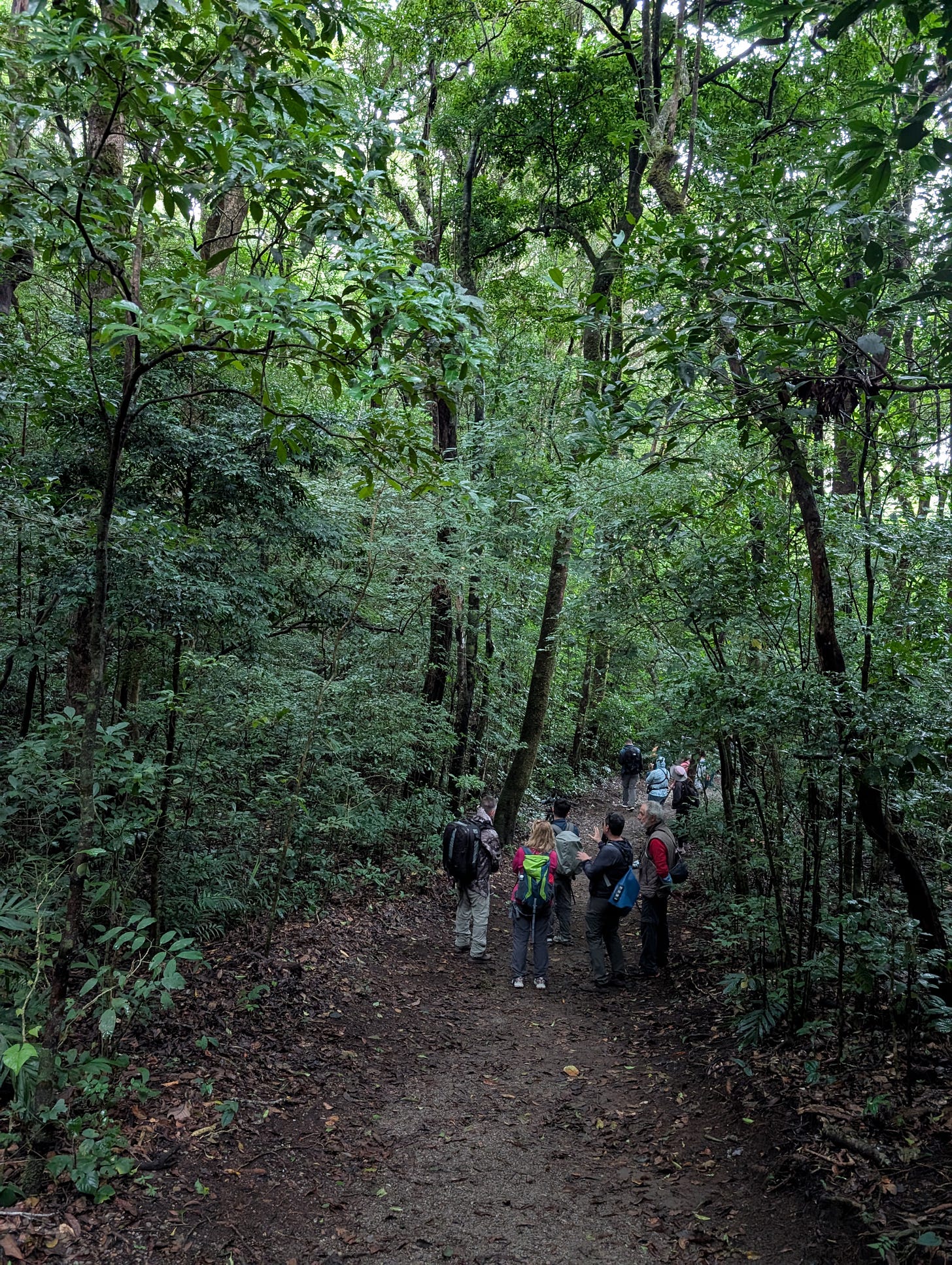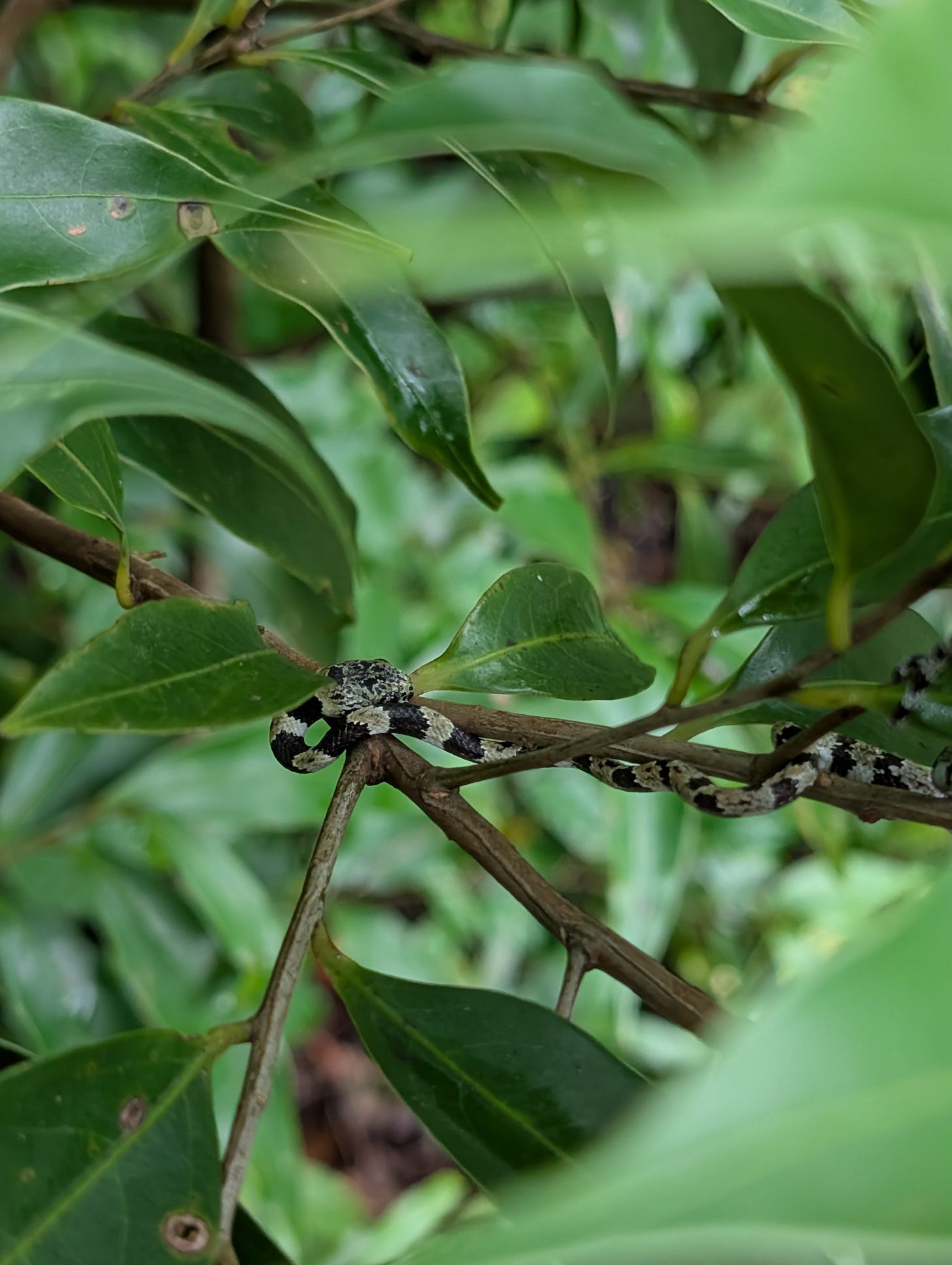Birds and Human Watching at Curi-Cancha
Today I watched birds, and I watched people watching birds at one of the most renowned birding destinations on the planet: the Curi-Cancha Reserve at Monteverde, Costa Rica.
Unlike birders and their birds, I’m pretty terrible at finding my favorite animal, snakes, so I’ve been dabbling in birding cuz birds are pretty much everywhere. Around 11,000 bird species live around the Earth, and wherever you are you can usually find some of them.
Especially at a place like this.
What makes Curi-Cancha so special is that the climate is just right for 200+ species of birds to call it home, and the habitats are a mix of forests and open pastures that make it more accessible to find them compared to some other forests that are too dense to see what’s lurking in there (like the Santa Elena Cloud Forest we visited the other day).
One of its residents includes the Resplendent Quetzal that is one of the most beautiful and sought-after birds on Earth to find. We hoped to find one too, although our guide managed expectations and said he’d only seen three in the last month — and this was coming from someone who regularly visits the reserve for hours as a professional birding guide. But hey, you never know.
Quite the place to “dabble” in birding.
I also told him I’d love to find a side-striped palm pit viper, at least to put it on his radar in case there was a chance of an encounter. In the Arenal/La Fortuna area a few days ago my target was the eyelash viper, but side-striped palm pit vipers thrive more at higher elevations like the cloud forests, so this was the spot to find them. But he said that would also be a pretty uncommon sighting here, at least during the day like this. I said I’d gladly take any snake. But snakes really are more of a night thing to find here.
I was still excited to find birds though.
Slow Birding
It took us a good 15 minutes just to get from the parking lot to the entrance as we kept finding things, like the keel-billed toucan that our guide pointed out through his spotting scope. We had seen the yellow-throated toucan, but this one is even prettier in my opinion.
We also saw a Golden-olive Woodpecker (Colaptes rubiginosus) that seemed special from the guide’s reaction and a few others whose names I don’t recall. Marcos kept a log of each encounter in the eBird app from Cornell University which provides data for ornithologists to understand distribution ranges, seasonality of encounters, migratory patterns and more.
The reserve limits visitors to just 50 people per day, and it seemed that most of them were accompanied by a guide. Many of them had fancy cameras with huge telephoto lenses and tripods they lugged around.
What other animal on Earth goes out of its way to simply observe other animals for the sheer joy of it like this? Humans are such weirdos.
Marcos could seemingly make dozens of bird calls as he whistled different sounds throughout our 3-hour walk to call out for different species. We would occasionally hear his same whistle sound repeated back to us and we’d follow the sound to (try) find the bird.
At one point we followed the bird whistle response over a hill where we saw another group of visitors with their guide, who was making the same whistle sound.
There we were, two humans paid by other humans to find birds, just making bird sounds at each other. If I were an alien observing human behavior (which I might be and you’d never know it cuz we camouflage really well), I’d be taking some notes on this.
What a fascinating species.
Exciting Early Finds
Just as I’d experienced with our night walk guide and the snake guides, Marcos had various moments of sheer excitement as there was always something unique to discover for him too. The most exciting find for him was a Tinamou, which is a small primitive bird species related to ostriches and emus that someone unfamiliar might mistake for a weird pigeon crossed with a chicken, except its lineage goes quite a bit further back, extending to around 80-90 million years ago. Fun fact: in this species, the males incubate the eggs and care for the chicks after they hatch.
“Primitive birds, but modern parents,” the guide joked. It ran right across the path in front of us, making it an even rarer sight as they are usually quite hidden in the brush.
There were plenty of others too with all kinds of names that were totally unfamiliar to me. Many weren’t all that pretty, but just as it goes with pretty much every other hobby that involves collecting or finding things — Pokémon, antiquing, treasure hunting — scarcity makes something more special. And if there’s a plain little brown bird that you rarely find, that’s quite a bit more special than a glimmering bird you see every day.
The most exciting for me so far wasn’t a bird, but an animal he said we likely wouldn’t find: a snake! This was a snail sucker, similar to what I’d seen a few nights ago near La Fortuna, but a different species from the genus.
A tiny little dude and such an interesting shape with their super skinny body and oddly large-shaped head in comparison. There it was just chilling in the daytime, way past its bed time. Lucky me.
I asked Marcos what bird would excite him most to find and he said that if we found an Umbrellabird we could pack our things up and go home cuz it just doesn’t get more special than that for him. He sees one of these guys once every three years or so.
I’d settle for my snail sucker. But in the world of birds I still thought a quetzal would be pretty special to find. So onward we kept looking.
Quetzal Trees
It was fascinating how well Marcos knew the different microhabitats within the forest, and he took us to a couple areas that he knew had a tree that produced fruit that quetzals like to eat.
As we approached one of these spots, we saw about 10 people huddled around two or three other guides with their scopes and binoculars pointed towards the trees. One of them played quetzal sounds from their phone as we all waited for a response in total silence.
Nothing.
Our guide joined in with his acoustic quetzal whistles and this went on for maybe 10-15 minutes (it felt like time stood still) as hope seemed to fade.
But things took a turn when the actual quetzal finally called back, and the entire group jolted back to life. You could feel a surge of adrenaline in the air. Apparently a few of them could even see the actual quetzal way in the distance through their $700 binoculars (at least Marcos’s pair were that much, but some pairs range in the thousands), but it was barely a glimpse and not much of a sighting to do this beauty justice. I kept scanning the trees as well and counted myself lucky when I eventually caught the brief flash of its bright red belly when the quetzal flew away.
A couple minutes later someone a bit further down the trail exclaimed that they spotted it, and our entire group scurried over, massive telephoto lenses and scopes and bulky camera bags and all.
And then back once again to the original spot when we heard it in that direction again.
I just watched the humans scurry and watch for the bird and thought it was the most interesting thing ever. What a striking human characteristic it is to act in such a way. Do dolphins do this with starfish? Or maybe elephants go people-spotting just for the hell of it? Who else in the animal kingdom has mastered survival to a degree where they’ve even got that kind of time and energy anyways?
Back at the original spot, our moment finally came when the brilliant resplendent quetzal perched for us to get a better look — a bit in the distance and best viewed with the scopes yet — but still just a stunning bird glimmering in green and yellow with a fuzzy head that didn’t even look real. It didn’t stick around long enough to get photos, so you’ll just have to take my word for it that it was something special.
It Gets Better
As if the quetzal weren’t special enough, later in our walk — after playing in a labyrinth made of bushes where my 4-year-old daughter tripped and cried for my help and I ran after her but kept running into dead ends as I had to solve the maze myself to find her even though she was only a couple feet from me at one point just behind some thick bushes, and when I did find her I accidentally bopped her in the face with the heavy binoculars that my guide let me borrow just to make the situation more absurd ... modern parenting at its best —the guide told me he’d found something for me.
“Bothriechis lateralis,” he said to me with a grin.
Wait, “Bothriechis” — isn’t that a snake? But I’m not great at Latin names and asked him what the common name was.
“Side-striped palm pit viper.”
My heart raced as we walked down the path, but he wasn’t too hurried — these guys tend to just sit perched in the same spot for a while, sometimes even for an entire day or two as they wait to ambush little animals like rodents, frogs, and birds.
And there it was, perfectly perched on a plant to show off those bright green keeled scales, white stripes on the side, and a badass look in the eyes. Larger than any of the eyelash vipers we’d seen the other day, maybe around 3 feet I’d say. A true beauty.
Another small group of visitors passed by us, and one of them ran up to get a closer look as well. “Oh my god, I love snakes,” she said. A kid perhaps in his 20s also stopped to look and called back to his parents. “Eine Schlange!” — German for “a snake!”
What weirdos. All of us. For some it’s the birds. For others it’s the snakes. And for me it’s the birds, the snakes, the humans, and the rest of it. We just like to watch other living things do their thing. And who knows, maybe somewhere out there, aliens are watching us do ours.
From Planet Earth,
Doug






